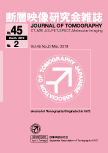Quality assurance of CT number–relative electron density
conversion table for dose calculation using CT images with single
energy projection-based MAR technique
Shogo Hatanaka 1), Kazutoshi Kodama 1), Tetsuya Watanabe 1),
Masatsugu Hariu1), Rikana Soda1), Kana Washizu1), Nobuko Utsumi 1,2),
Takafumi Yamano 1), Keiichiro Nishimura 1), Keisuke Todoroki 1),
Katsuhito Hosaka 1), Munefumi Shimbo 1), Takeo Takahashi 1)
1)Department of Radiation Oncology, Saitama Medical Center, Saitama Medical University
2)Department of Radiology, JCHO Tokyo Shinjuku Medical Center
Abstract
A metal artifact reduction(MAR)technique can reduce beam hardening and streak artifacts caused by metal in the body on computed tomography(CT). In this study, we evaluated a CT number–relative electron density(CT-rED)conversion table in dose calculation using CT images with MAR technique. Materials and methods: CT images of a RMI-467 cylinder-type solid water phantom, 16 normal rods (rED: 0.28 to 1.69), a titanium rod(3.79)and a stainless-steel rod(6.58)were acquired for the CT-rED table. Four CT-rED tables were created using the CT images with single energy projection-based MAR techniques: normalraw(without MAR), normal, normal + titanium and normal + titanium + stainless steel. The CT numbers were compared between CT-rED tables normalraw and normal. CT images of 23 patients(36 plans and 159 beams in total)were used. Monitor unit(MU)calculations were performed using each CT-rED table and each patient’s data. The differences of the MUs acquired using the high-density material data relative to those of the MUs acquired using normal CT-rED table were calculated. Results: The changes in CT number due to MAR were very small(0.1 ± 3.2 HU). The greater the maximum rED input to the CT-rED table, the greater the variation of the calculated dose. Nevertheless, all relative differences were within 1%. Conclusion: The creation of a dedicated CT-rED conversion table for the CT images with single energy projection-based MAR techniques might not be necessary.
Key words :
Radiation therapy, computed tomography, CT number–relative electron density conversion table, metal artifact reduction technique
|
